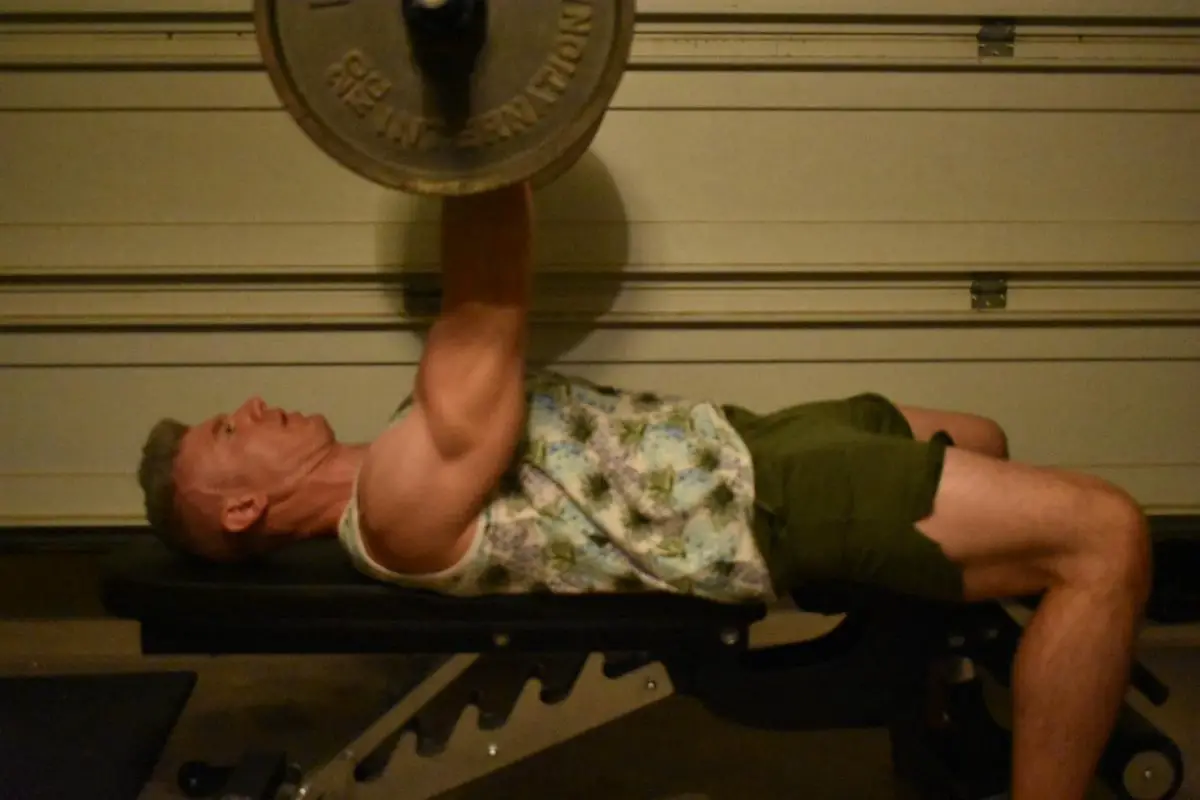Almost 4 years ago, I injured my left shoulder by benching with some heavy dumbbells. I found out recently it’s a torn labrum. I am having it treated now and hopefully it will be whole again soon.
In the meantime, I have spent many hours looking into alternative chest exercises. All of my old favorites; flat bench press, incline bench press, and dips aggravate it quite a bit, so my options have been very limited.
I remembered reading an article on T-Nation from years and years ago about the reverse grip bench press and how great it was.
At the time I read the article, I could do any exercise I wanted so I didn’t buy into it too much. Luckily that knowledge surfaced when I needed it most.
As it turns out, I wish I would have been reverse grip bench pressing all this time. It’s a fantastic exercise and may even be better for chest development than the regular bench press.
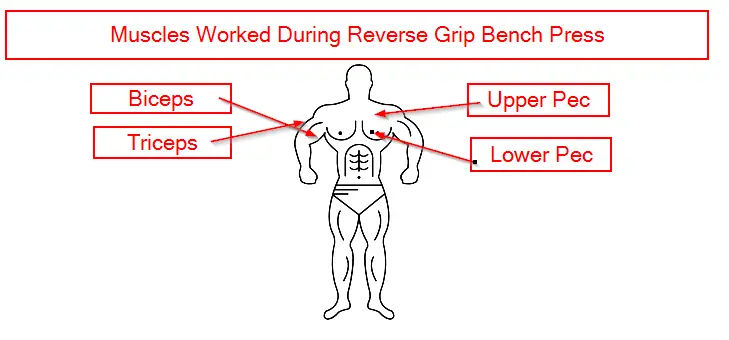
Reverse Grip Bench Press Benefits
Bench Press is the king of all chest exercises, right? I am beginning to wonder how true this is. I have been bench pressing for 20 years. I have benched over 300lbs for reps, benched for very low volume with heavy weight and benched for high volume with light weight.
One thing has been true no matter the volume or weight…… I barely feel it in my pecs.
When bench pressing, I get a great pump in my triceps and shoulders. I can feel the triceps and shoulders working and can feel the mind muscle connection. Not so much with my chest.
Now, reverse grip bench press is an entirely different story.
The first time I tried it, I immediately felt the pecs contract. Not only did I feel the contraction, but it was a full, deep contraction unlike I had experienced before. Not from pec flys, dips, bench, or any other exercise had I ever felt this level of mind-muscle connection with the pecs. It was amazing.
The benefits don’t stop there. Not only were my pecs contracting, but both my triceps AND BICEPS were contracting too! Who would expect to feel a bicep contraction during a chest exercise?
Another benefit I experienced from the reverse grip bench press was a lack of deltoid activation. My pecs, biceps and triceps were doing most of the work. For the first time during a bench press, my shoulders were not the first to give out from carrying the load.
While performing the reverse grip bench press, you are working many muscles including your pecs, biceps, triceps, frontal deltoids and side deltoids. Primarily, you are working the muscles that will lead to bigger arms and chest.

Reverse Grip Bench Press for Upper Chest
Most sources are going to tell you that the reverse grip bench press is an upper chest exercise. I don’t disagree, but I’m here to tell you that it’s a lower chest exercise too.
The reverse grip bench press is an all-encompassing chest exercise.
Everyone likes to site This study which showed an increase in activity for the clavicular portion of the pectoralis major (upper chest) when bench pressing with a supinated (reverse) grip.
What everyone seems to miss is what the study does not say. At no point did the study indicate that bench pressing with a reverse grip would decrease the activity in the lower chest.
In fact, the study says that benching with a narrow grip decreased lower chest activation, BUT when the grip was reversed, lower chest activation was not decreased!
My interpretation of this study is that bench pressing with a reverse grip increases upper chest activation without hindering lower chest activation. So, you should get all the lower chest benefits of bench pressing PLUS added upper chest benefits.
I contacted Dr. Greg Lehman, the author of the study, for his opinion of my interpretation but he has not yet responded. I will update this article when he does.
Beyond the study, I can tell you from personal experience that the reverse grip bench press is an awesome exercise for developing a full chest.
Reverse Grip Bench Press for Triceps
Just like a standard flat bench press, the RGBP utilizes the triceps in addition to pec muscles to push the weight.
If your goal is to get the most out of your triceps during your reverse grip bench press session, I recommend using a closer grip.
The same study I referenced earlier noted an increase in triceps activation when a close grip was used while bench pressing.
This is true for both a standard or reverse grip bench press. The closer the grip, the more triceps activation.
This study I keep referencing shows that during a normal bench press, lower chest activation is decreased when benching with a narrow grip.
This means that with the standard bench press, a narrow grip increases triceps activation but decreases chest activation.
What’s unique about the reverse grip bench press is that you can narrow your grip, increasing triceps activation, without decreasing chest activation.
According to the study, pec activation was not decreased when a narrow grip was used, if a reverse grip was used.
As I interpret this study, this means that you can increase triceps activation by using a narrow grip, without decreasing chest activation, as long as the reverse grip is used.
Sounds pretty good right?
The reverse grip bench press is definitely a great triceps exercise, in addition to being an awesome pec exercise. This makes it perfect for getting bigger arms and chest.

Reverse Grip Bench Press for Biceps
Biceps during a bench press exercise? That’s right. Unlike the standard bench press, the RGBP works the Biceps in addition to working the triceps and pecs. This one exercise works all the muscles of the arms and chest.
Due to the position of the elbow and shoulder, the biceps are more involved during the lift; especially during the concentric portion. As you lower the weight, your biceps assist to prevent the weight from lowering too quickly.
Have you ever done forced negatives? This is where your spotter assists you with the lifting of the weight, and then you are responsible for slowly lowering the weight. You can’t lift it on your own, but you can prevent it from lowering too quickly.
The Reverse Grip Bench Press is almost like doing a set of forced negatives for your biceps. They are trying to manage the weight but need assistance from the triceps and pecs.
It’s unlikely that bicep strength will prevent you from preforming the lift, so don’t worry if your biceps aren’t up to par with the rest of your arms and chest. Do the RGBP for a while and they will be!
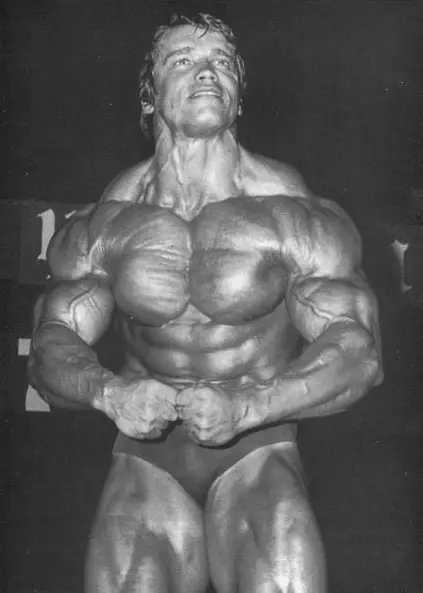
Reverse Grip Bench Press Form
Flex your pecs. Do it. Now, lift your arms up to 90 degrees and try to flex your pecs. What did you find? I’m guessing that you couldn’t get a good flex with your arms up.
Have you ever seen a bodybuilder flex his chest on stage? Look at the above image of Arnold. What position are his arms in? I believe you will find that his arms are down and his elbows and hands are around his lower stomach/ bellybutton.
The natural position in which it is easiest to flex the chest / pecs is with our arms down at around 15 or 20 degrees.
What does this matter?
Proper form during the Reverse Grip Bench Press naturally puts us in this position! I believe this is the RGBP’s secret to chest activation and improved mind muscle connection. You are able to flex the pecs during the exercise because the exercise puts you in a position where it is naturally easy to flex the pecs!
Most of us do a regular bench press with our arms at a 65-75 degree angle. While it’s possible to flex the chest at this angle, I find it far more difficult.
Form is quite different between the regular bench press and reverse grip. With reverse grip, your racked bar will be over your chest, but slightly lower than with a standard bench press.
As the weight moves towards your chest, it will move slightly towards your feet, putting the bar just under your chest in the down position.
As you raise the bar, it will not only move up, but also slightly towards your head. I believe this slight forwards and backwards movement adds to the pec contraction.
Grip width is variable but I find a shoulder width grip to be the most comfortable. This is also where I get the greatest contraction.
You will find that performing this exercise with proper form, will put your arms at around a 15 to 20-degree angle from your torso.
A special note on racking and unracking. If you lift alone as I do, you might find it difficult to rack and unrack the bar to perform the RGBP.
To solve this problem, I perform the exercise in my power rack and start the lift in the down position with the bar sitting on the safety bars of my rack.
I also end the set in the down position. I set the safety bars so that they barely allow me to squeeze out from under the bar. If you set the safety bars just right, you can still perform full range of motion.
Performing RGBP this way allows me to lift the maximum amount of weight, without being concerned about dropping it on my face while starting or finishing the exercise.

Reverse Grip Bench Press for Shoulder Pain
I started this article by saying a shoulder injury led me to discover the benefits of the RGBP. While I’m certainly not glad that I injured my shoulder, I am very glad that I found the reverse grip bench press. This exercise has certainly added to my chest gains.
The reverse grip bench press tends to put less stress on the shoulder joint than the regular bench press.
The natural arm position of the press and supinated (reverse) grip allow the shoulders to be in a more externally rotated position during the exercise. This makes shoulder impingement less likely.
There are many different types of shoulder injuries and issues. The reverse grip bench press may not be a suitable exercise for everyone with an injury.
For me personally it has been a blessing. The RGPB has allowed me to continue to press despite having a torn labrum.
Where the regular bench press aggravates my injury, I barely feel it while performing the reverse grip.
How to Avoid Wrist Pain While Performing the Reverse Grip Bench Press
The main complaint I hear about the RGBP is that is causes wrist pain. I understand. It causes me wrist pain too.
The issue is that many weight lifters can’t supinate their forearms quite enough to comfortably grip the bar in the reverse position.
This issue can be resolved in a number of different ways.
Reverse Grip Dumbbell Bench Press
Doing a reverse grip bench press with dumbbells is a great alternative for anyone with wrist pain. I like this exercise quite a bit and do it frequently.
I particularly like performing the dumbbell variant with a close grip and love the squeeze / contraction at the top of the press.
The reverse grip dumbbell bench press allows you to rotate the dumbbells into a slightly more neutral position, relieving stress from the wrists.
The problem with using dumbbells is that they limit your ability to progress. You are going to run out of dumbbells before you run out strength potential.
Check out this video of Greg Nuckols Reverse Grip Bench Pressing 405lbs. Do that with Dumbbells!
If you are going to use the reverse grip bench press as a regular bench press replacement, you need to be able to move heavy loads. Dumbbells just won’t do it.
I would stick to using the reverse grip dumbbell bench press as an auxiliary exercise. Perhaps the 2nd or 3rd exercise in your chest routine.
So, what do you do if you want to RGBP HEAVY but you have wrist pain? Here are some options.
Use a Straight Bar but Change Your Grip
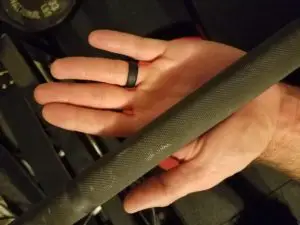
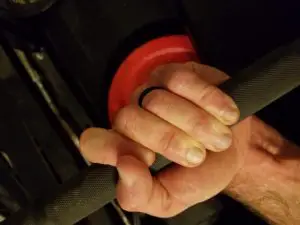
One option to minimize wrist pain is to change your grip. Instead of gripping the bar with the bar running horizontally across your hand, try gripping the bar at a slight angle.
The bar should run from the top of your palm on your thumb side to the middle of your palm on the bottom.
This may be uncomfortable for your hands, but it should allow you to perform the exercise successfully.
What if you don’t want to deal with the hand pain? I have the solution.

Use a Curl Bar!
This is my favorite. A curl bar will allow you to perform the RGBP without the wrist pain associated with the straight bar.
Your wrists will be in a slightly less supinated position than with the straight bar, but still supinated.
It will feel much like the dumbbell variant, but will give you the stability of a barbell. I am able to bench press using this method without wrist or shoulder pain.
There is one problem though. A curl bar isn’t rackable. You can’t use it in your power rack or bench press station. You can’t load it up, un-rack it and perform the exercise.
Much like with dumbbells, you are going to reach a point where you can no longer pick the weight up off the floor to perform the exercise. Again, you are limiting yourself with your equipment.
So, what’s the solution?

The Rackable Curl Bar
“What?! There’s a rackable curl bar?” Yes sir, there is. The rackable curl bar works exactly as the name implies. It’s a curl bar with standard curl bar grips. The difference is that each side of the bar, past the curl bar grips, is extended. You WILL be able to rack the bar in your bench press station or power rack.
What an amazing discovery this was for me. This bar will not only allow you to reverse grip bench press without wrist pain but it will allow you to keep progressing until you run out of plates. (Actually, the bar I suggest is rated for 400lbs, so there is a limit, but I think it’s going to be a while until you get there)
The rackable curl bar I suggest is called “The Warden” It’s made by Xmark and it sells on Amazon for $119. Click on this link if you want to check it out for yourself
Suggestion: If you have a home gym, click this link to check out an article I wrote about the best all-in-one machine.
What About the Incline Reverse Grip Bench Press?
The incline reverse grip bench press is quite possibly the ultimate exercise for upper chest development.
Research shows that the RGBP increases upper chest activation by up to 30%.
This study shows that bench pressing in the incline position increases chest activation by around 5%.
What that means is a combined increased upper chest activation of 35% over the standard bench press. I believe it could be more, but there is not a study on the incline reverse grip bench press specifically.
In my experience, the standard incline bench press is great at working the deltoids, but not so much the pecs. I have spoken to many fellow lifters who share this same concern.
The incline reverse grip bench press takes some of the pressure off of the shoulders which allows you to really contract your chest. I find I get a much better contraction and have far more mind muscle connection, compared to the standard incline bench.
Recap and Conclusion
The benefits of the reverse grip benefits are vast. It’s a great exercise for anyone looking to develop a full chest and bigger arms. The RGBP is not just an upper chest exercise, but an exercise that will develop the upper and lower pecs, triceps and biceps too!
The Reverse Grip Bench Press……
- Is a great upper chest exercise.
- Is a great lower chest exercise.
- Works the Biceps.
- Works the Triceps.
- Works the shoulders.
- Is a great exercise to try if you suffer from shoulder pain.
- Offers variations for people with wrist issues.
If you are looking for the one upper body exercise to develop bigger chest and arms, give the reverse grip bench press a try. I believe you will be enjoy the exercise and find the contraction, pump, and mind muscle connection you are looking for.
Follow me / Pump Some Iron on Instagram for updates @pump.some.iron

